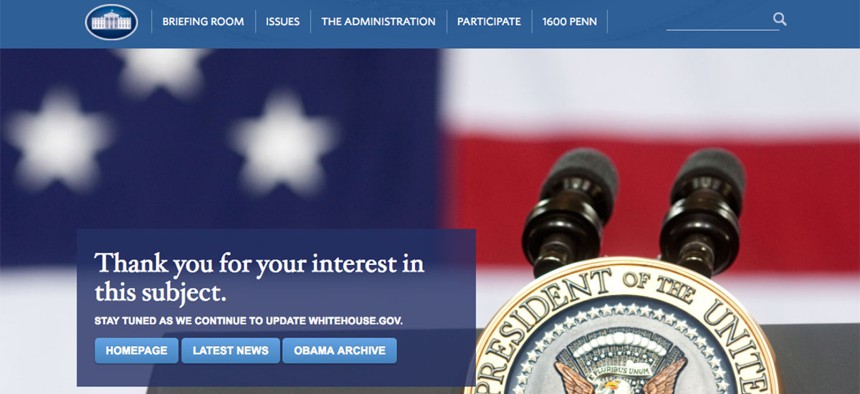What’s Up With the Office of Management and Budget Website?

https://www.whitehouse.gov/omb
Currently, the integral agency—a repository for memoranda issued by the executive branch—is without a website.
The Office of Management and Budget is the largest unit within the Executive Office of the President and responsible for helping the president formulate a budget and measure how well federal agencies perform and comply with administration policies.
Currently, the integral agency—a repository for memoranda issued by the executive branch—is also without a website.
For the past week, the site has offered visitors a single “stay tuned” prompt with a link to former President Barack Obama’s White House archive. Other sites that are offshoots of the Executive Office of the President, like the White House Office of Science and Technology Policy, return a similar message.
» Get the best federal technology news and ideas delivered right to your inbox. Sign up here.
Some have taken issue with the content of the White House website—site links for civil and LGBT rights and climate change were removed last week, and others have voiced privacy concerns—but the issue plaguing OMB’s site is simply that there isn’t any content.
Officials at OMB did not provide an explanation for the delay to Nextgov.
The lag to get some executive branch websites up and running is not unusual, said Mark Forman, who served as the government’s top tech official under President George W. Bush from 2001-2003.
Forman, who is now the global head and vice president of Unisys public sector, told Nextgov people on the outside don’t realize the massive workload that goes into removing one administration’s content and replacing it with new content from scratch.
“It’s kind of expected,” Forman said. “Ten years ago, we had 28 million web pages, and now there’s more than double that, and add in the complexity of all kinds of CMS tools and generations of websites.”
Forman said Trump’s team has to identify every piece of content that has Obama’s name on it and replace it with something else. Then, that content has to be deployed in a pre-production environment and tested to ensure it’s safe for today’s cybersecurity concerns.
It took months, Forman said, to wipe mentions of former President Bill Clinton and his policies to make way for new ones under Bush, and those were the early days of the government’s foray into the web.
It’s hard to quantify how much content falls under the federal government’s purview today, but the General Services Administration publishes an official dot-gov parent domain list (click here for a visualization). According to GSA, the federal government hosts “around 1,000 live executive branch .gov parent domains” and another 26,000 live subdomains, each containing at least a single page of content.
In other words, it’s only been a week.
“Some years, they’ve done well putting the new governor’s name on the sign when you cross the bridge into Maryland, some years they haven’t,” said Forman, who lives in Maryland but commutes to Virginia. “That’s just a sign with a name on it. We’re talking about website content. The complexity is pretty high.”
NEXT STORY: Harris Sells Federal IT Business






